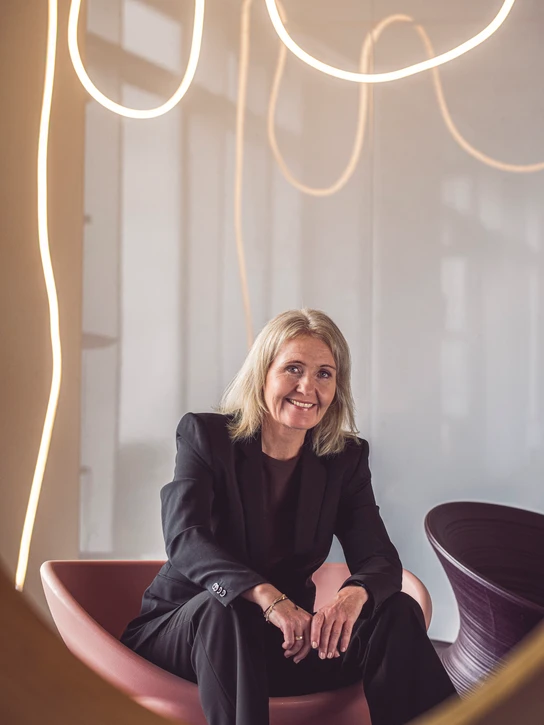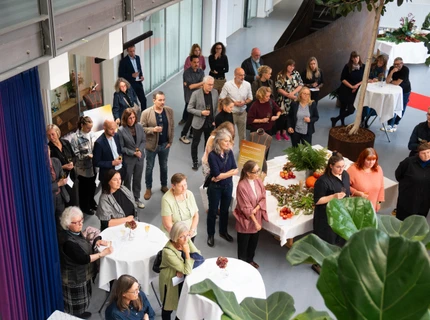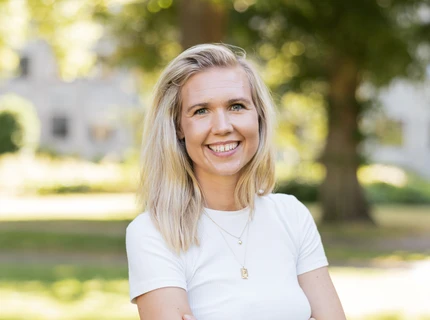
Designers don’t get nearly enough recognition for what they actually contribute to society. My goal is for businesses to start seeking out the specific skills our designers possess. But that means we also have to be proactive and clear about what we bring to the table. Photo: Kirsten Adler
Design thinking, social responsibility and greater visibility
As she steps through the doors of Kolding School of Design, Carina Christensen brings a blend of respect and ambition: respect for the school’s history and artistic foundations, and ambition to make it stronger, more visible, and more relevant to society. She sees design as uniquely positioned to tackle the complex problems of our time.
Unique skills for today’s challenges
- Design is about much more than form and aesthetics – it’s a way of creating change and finding new solutions to the major challenges the world is facing, says Carina Christensen. She highlights the climate crisis, accelerating technology, and pressure on welfare systems as areas where designers have a crucial role to play.
- We can help solve the really tough problems – the ones with no obvious answers. Design thinking gives us the tools to think outside the box and work creatively with big societal challenges. Designers have the ability to challenge established ways of thinking and acting – through both physical products and new processes. That’s exactly what our students excel at, she says.
Her goal is to ensure that students leave the school with the strongest possible foundation.
- Our students are at the top of my personal agenda. They deserve the best education, the best conditions, and a safe space to explore, experiment, fail and try again – because it’s through curiosity and courage that the most original ideas emerge. And we must make sure the job market fully understands what our graduates can do – and competes to hire them, she adds.
A jewel that shouldn’t stay hidden
That ambition requires visibility. A key part of Carina Christensen’s vision is to strengthen the school’s collaboration with the outside world.
- Too few people in the private sector understand what a difference designers can make. We need to be bold, visible, and proactive. I’m not one to sit back and wait for things to happen – we’ll reach out to companies, local authorities, organisations and international partners to show that we’re an attractive collaborator for anyone looking for innovative solutions, she says.
The school already works closely with partners such as the LEGO Foundation, Bestseller, Abena and local hospitals – but Carina Christensen sees far greater potential.
- Designers don’t get nearly enough recognition for what they actually contribute to society. My goal is for businesses to start seeking out the specific skills our designers possess. But that means we also have to be proactive and clear about what we bring to the table.
For Carina Christensen, Kolding School of Design’s artistic heritage is what makes it unique among higher education institutions. While universities are built on academic traditions, Kolding School of Design draws on a creative and playful approach – where material understanding, artistic experimentation and design thinking form the foundation for new solutions.
She sees it as a central task to ensure the school stays true to that artistic identity, while also showing how design can drive social change – especially in the face of global resource challenges.
- Our deep knowledge of materials gives the school a real advantage in a world where sustainability is key. From here, we can show others how to design circularly, reuse materials, and develop innovative solutions, she says.
A joyful reunion with a unique institution
For Carina Christensen, her appointment marks a return to an institution she has long admired. As Minister for Culture, she had a special fondness for Kolding School of Design, and her political career often brought her close to its work.
- There was a real affection for the school within the Ministry of Culture. We were proud to have such a strong design and arts institution under our wing. That’s why I’m so excited and proud to take on the role of Rector today – and I can honestly say that pride is still very much alive, she says.
- When the time eventually comes to pass the torch, I want to be able to say that we’ve preserved and developed what makes this school special: the artistic, the craft-based and the experimental. And that we’ve shown the world that design isn’t just about form – it’s about taking responsibility for the future. I’m genuinely thrilled to help make the school even stronger in the years to come – for the benefit of students, staff, and society at large.
Although many may know her from her time in politics, Carina Christensen has spent over a decade working outside Parliament, leading organisations and companies across sectors.
- Many still see me as a politician, but I’ve spent more than ten years working beyond Christiansborg – in leadership roles that demand collaboration across industries. That’s the experience I’m bringing to the school, she concludes.
Biography
- Carina Jelling Ørnbo Christensen, born 1972
- Master’s degree in International Business and Modern Languages (Cand.negot.), University of Southern Denmark
- Member of Parliament for the Conservative Party, 2001–2011
- Held three ministerial posts between 2006 and 2010, including Minister for Culture (2008–2010)
- Product developer and later owner/director of the family company Rugballe Møbelfabrik, 1998–2015
- Director in several organisations, including GRAKOM (the Communication Industry), the ITD Group (International Transport Denmark), Nordic Innovation (Nordic Council of Ministers) and Udvikling Vejen, 2012–2025
- Lives in Middelfart with her husband and two children

There’s a special pride in leading an internationally recognised design school outside the capital, says Carina Christensen, who has deep roots in and still lives in the Triangle Region. "I’ve always been proud that we have a school of this calibre here. It means a lot that Kolding and the region can point to an education of world-class quality. It inspires local pride – and shows the rest of the country what we’re capable of. I’d love to invite the local community along on the journey, so they can be ambassadors for the school." Photo: Kirsten Adler


